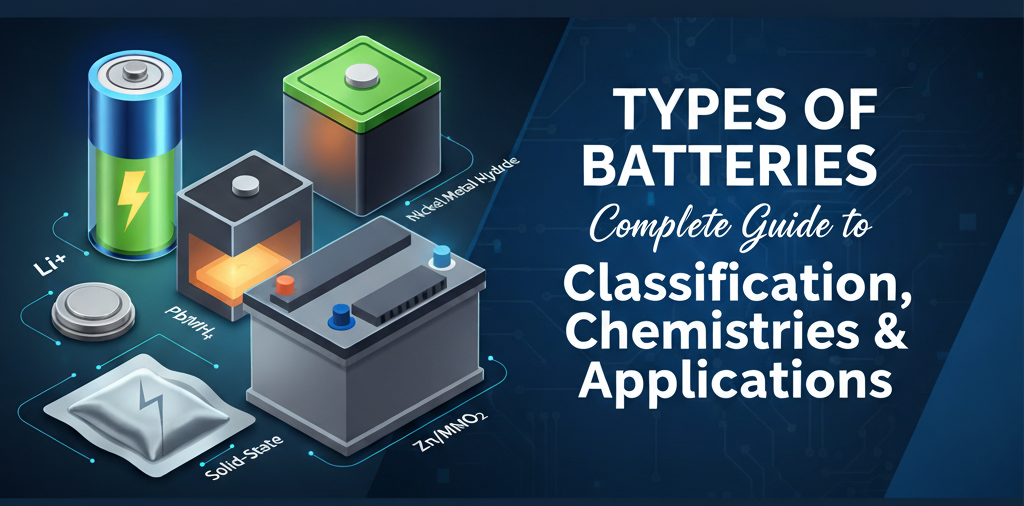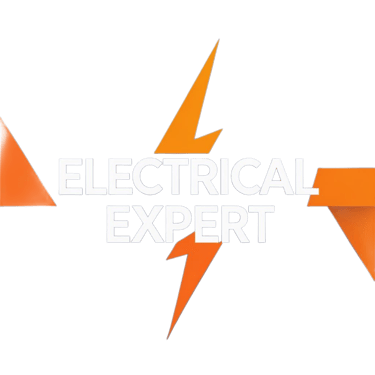Exciting News: E-Books Launching Soon !!
Types of Batteries: Complete Guide to Classification, Chemistries & Applications
Discover the different types of batteries—Primary vs Secondary, Lead-Acid, Nickel-based, Lithium-ion (LFP, NMC, LTO), Flow, and emerging technologies like Solid-State and Sodium-Ion. Learn their features, applications, and future trends in this comprehensive guide.


Types of Batteries: Classification, Chemistries, Applications & Future Trends (बैटरियों के प्रकार: वर्गीकरण, रसायन, अनुप्रयोग और भविष्य की दिशा)
Introduction:
Batteries power our daily life and the clean‑energy transition—running phones and laptops, enabling electric vehicles (EVs), and storing solar/wind power for the grid. The last decade brought rapid gains in energy density, cost and safety, pushing lithium‑ion to dominance while opening space for flow and sodium‑ion in stationary storage.
1) Classification of Batteries | बैटरियों का वर्गीकरण
At the top level, batteries split into primary (non‑rechargeable) and secondary (rechargeable)—a simple distinction that drives use‑case and total cost of ownership.
Primary Batteries (Non‑Rechargeable) | प्राथमिक बैटरियां
Primary cells are single‑use; their chemistry isn’t designed to reverse. Typical examples include Alkaline (everyday remotes, toys), Zinc‑Carbon (clocks, torches) and Primary Lithium (coin cells, cameras, medical devices). They offer long shelf life and low self‑discharge but create disposal burdens and ongoing replacement costs for high‑drain loads.
Secondary Batteries (Rechargeable) | द्वितीयक बैटरियां
Secondary chemistries—Lead‑Acid, Nickel‑based (NiCd, NiMH), Lithium‑ion families, and Flow batteries—support repeated charge/discharge cycles, making them essential for EVs, UPS, telecom, and grid storage where lifecycle economics matter.
2) Major Battery Chemistries | प्रमुख बैटरी रसायन
2.1 Lead‑Acid (LA) | लेड‑एसिड
Where it fits: Automotive starter batteries (SLI), inverters/UPS, forklifts, telecom backup—thanks to low upfront cost, robustness, and mature recycling. Trade‑offs are low specific energy (heavy), moderate cycle life, and maintenance (for flooded types). In India, LA remains common in home inverters/UPS due to cost sensitivity and widespread service networks.
2.2 Nickel‑Based (NiCd, NiMH) | निकल‑आधारित
NiCd is rugged with high discharge rates and wide temperature tolerance, but cadmium toxicity and memory effect pushed it to niche roles. NiMH improved energy density and reduced toxicity, finding a place in hybrid vehicles and consumer rechargeable before Li‑ion overtook both.
2.3 Lithium‑Ion Family | लिथियम‑आयन परिवार
Lithium‑ion spans multiple sub‑chemistries, each optimizing energy density, power, safety, or life:
LFP (Lithium Iron Phosphate) — High safety and thermal stability, long cycle life, slightly lower energy density than NMC; popular in EV buses, two‑wheelers, home/utility storage.
NMC (Nickel Manganese Cobalt) — High energy density for longer‑range EVs and space‑constrained devices; careful thermal management needed.
LTO (Lithium Titanate) — Exceptional fast‑charge and cycle life (often 10,000+), excellent low‑temperature performance, but higher cost and lower energy density.
Why Li‑ion leads: Superior energy density, round‑trip efficiency, and low maintenance, with maturing supply chains and safety systems (BMS, thermal design). For stationary storage, LFP has become a favorite because of its benign cathode chemistry and value at 2–6‑hour durations.
2.4 Flow Batteries (VRFB, Zn‑Br) | फ्लो बैटरियां
Flow batteries store energy in liquid electrolytes kept in external tanks; power (stack size) and energy (tank volume) scale independently. They thrive in long‑duration (>4–12 h) cycling with deep DoD and long life, making them compelling for grid renewable firming where footprint is available. Present limits are capex and system complexity relative to Li‑ion containers.
3) Emerging & Next‑Gen Chemistries | उभरती और अगली पीढ़ी की रसायन
3.1 Solid‑State Batteries (SSB) | सॉलिड‑स्टेट
SSB replace flammable liquid electrolytes with solid conductors, targeting higher safety, energy density, and potentially faster charging. Automotive pilots are underway; mass adoption hinges on manufacturability, interface resistance, and cost. Expect early adoption in premium EVs and aviation/defense niches before mainstream scaling.
3.2 Sodium‑Ion (Na‑ion) | सोडियम‑आयन
Sodium is abundant and low‑cost, enabling supply diversification away from lithium/cobalt. Na‑ion cells show improving energy density adequate for stationary storage and short‑range mobility, with promising research on solid electrolytes and low‑temperature performance. Several manufacturers announced pilot lines, and academic labs demonstrated anode‑free solid‑state Na prototypes with stable cycling—signaling a credible pathway for cost‑effective grid batteries.
3.3 Zinc‑Air & Beyond | जिंक‑एयर और अन्य
Zinc‑air leverages atmospheric oxygen as the cathodic reactant, offering high theoretical energy density and zinc’s widespread availability. Lab‑to‑market momentum is building for stationary storage use‑cases that value cost and safety over volumetric density, alongside parallel progress in metal‑air and lithium‑sulfur research roadmaps.
4) Applications & How to Choose | अनुप्रयोग और चयन‑मार्गदर्शिका
Consumer Electronics | उपभोक्ता इलेक्ट्रॉनिक्स
Smartphones, laptops, wearables lean on Li‑ion (LCO/NMC/LFP variants) for compactness and energy density; primary Alkaline still rules remotes, toys and wall clocks due to convenience and low cost.
Electric Mobility | इलेक्ट्रिक मोबिलिटी
Two/three‑wheelers and buses often use LFP for safety and life; passenger cars toggle NMC (range) vs LFP (value). Niche fleets (airport tugs, BRT buses) explore LTO for ultra‑fast charge and longevity. Chemistry choice balances pack volume/weight, thermal safety, charging strategy, and TCO.
Grid & C&I Storage | ग्रिड और वाणिज्यिक‑औद्योगिक
For 1–4 hour services—energy shifting, peak shaving, frequency response—LFP Li‑ion dominates thanks to containerized systems and mature EPC stacks. Where 6–12+ hour duration or heavy cycling is paramount, flow batteries and, increasingly, Na‑ion are compelling. Project developers size around duty cycle, augmentation strategy, auxiliary loads, and interconnection constraints.
Backup Power & UPS | बैकअप पावर/UPS
Lead‑acid remains ubiquitous in home/office UPS due to low capex and serviceability; premium sites shift to Li‑ion for smaller footprint, better life, and lower HVAC burdens. Choice depends on runtime needs, ambient conditions, and service logistics.
Medical & Specialty | मेडिकल और विशेष अनुप्रयोग
Implants/sensors still rely on primary lithium (long life, stable voltage); high‑reliability carts/portable devices adopt Li‑ion with medically certified packs/BMS.
5) Performance Factors that Matter | प्रदर्शन के प्रमुख मापदंड
When evaluating a battery, look beyond nameplate capacity:
Energy & Power Density (Wh/kg, W/kg) — determines how much energy fits in your weight/volume, and how fast you can charge/discharge. LFP trades a bit of energy density for superior stability; NMC pushes range in EVs; LTO prioritizes power and life.
Cycle & Calendar Life — cycles at given DoD/temperature and aging over time. Thermal management and BMS quality are as critical as chemistry.
Round‑Trip Efficiency (RTE) — vital for storage economics; Li‑ion typically leads for 1–4 hour services, with flow competitive over long duration due to minimal degradation at deep cycles.
Safety & Thermal Behavior — inherent chemistry stability (LFP > NMC for thermal runaway tolerance), enclosure design, gas detection, and certified testing reduce risk.
Cost & Supply Chain — $/kWh is only the start; consider installation, augmentation, and end‑of‑life costs. Chemistries using abundant elements (iron, sodium, zinc) can buffer commodity swings.
Sustainability & Recycling — LA enjoys strong recycling infrastructure; Li‑ion recycling is scaling, while flow systems offer long service lives and easy electrolyte refurbishment.
6) What’s Next: Trends & Opportunities | अगला चरण: रुझान और अवसर
Cost trajectories continue to improve for Li‑ion (especially LFP), while manufacturing scale, non‑nickel chemistries, and supply diversification reduce volatility—benefitting both EV and stationary segments.
Long‑duration needs will expand—opening room for flow, Na‑ion, and hybrid portfolios (e.g., Li‑ion + flow) tuned to stacked services.
Recycling & second‑life: expect stronger reverse‑logistics for Li‑ion and second‑life EV packs feeding stationary storage, aligned with sustainability mandates.
Digitalization: smarter BMS/EMS, predictive analytics, and standardized interfaces will enhance safety, uptime, and asset monetization across markets.
